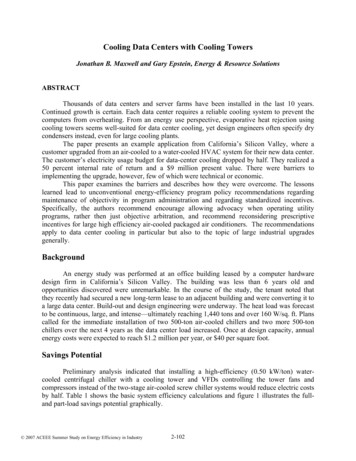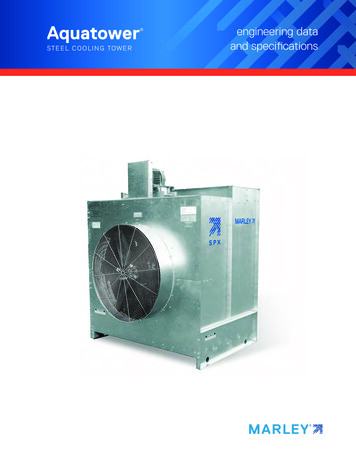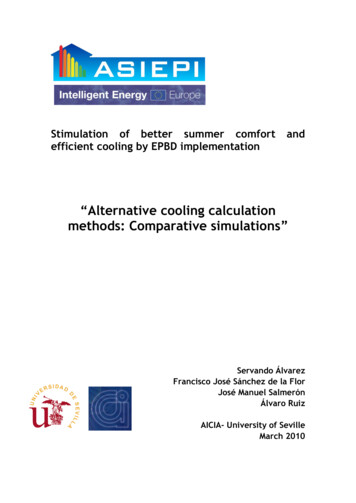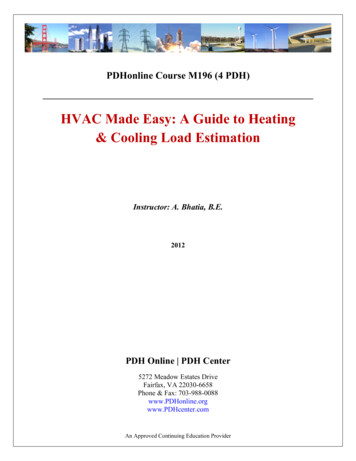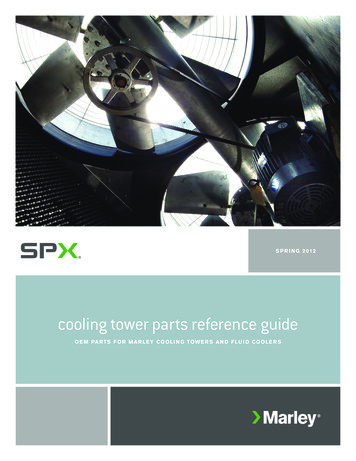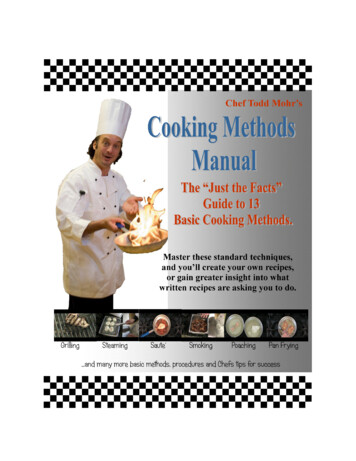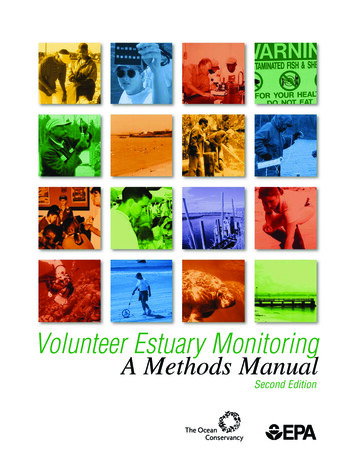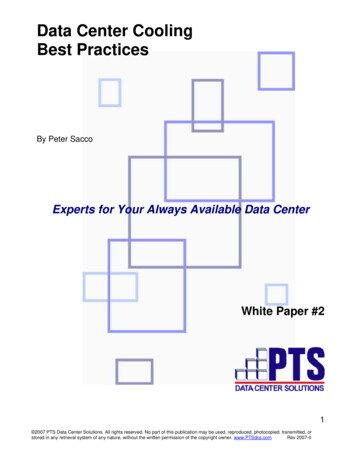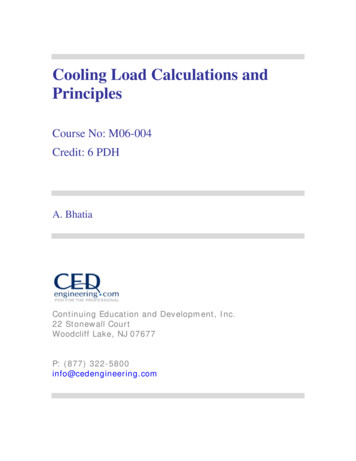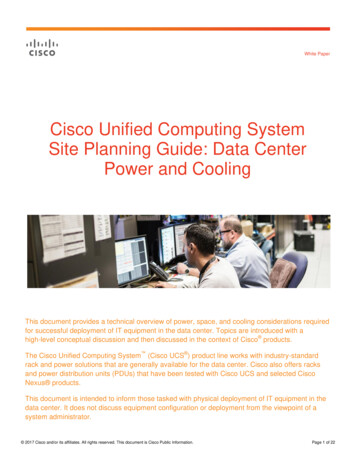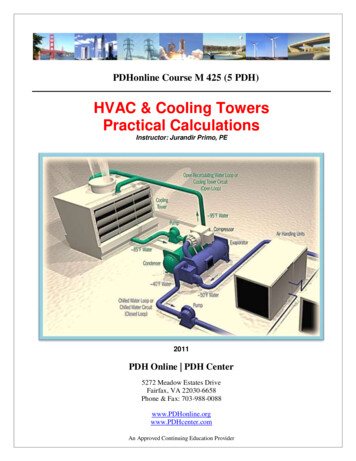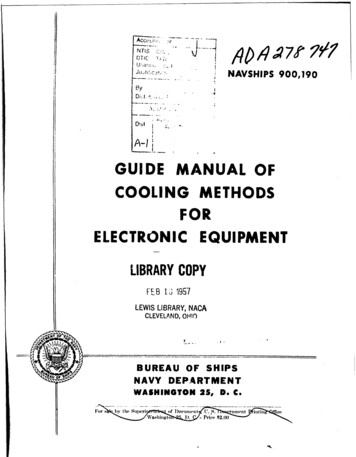
Transcription
""NAVSHIPS 900,190jPDyDim.L. IA-GUIDE MANUAL OFCOOLING METHODSFORELECTRONIC EQUIPMENTLIBRARY COPY3 19578FEBLEWIS LIBRARY, NACACLEVELAND, OHIOBUREAUtuOfNAVYOF SHIPSDEPARTMENT,:oMWASHINGTON 25, D. C,: ,, ,,,,;,;,,--rt 1oeipii;;, ,n.M.-.,.,itti,.'(
BestAvailableCopy
Navy DepartrentBureau of Ships31 March 1955"Guide Manual of Cooling Methods for Electronic Equipment", NAVSHIPS 900.190,was originally published as Cornell Aeronautical Laboratory, Incorporated,report Number HF-710-D-16, dated 1 April 1954, under Bureau of ihipsThis piblication is the third of a series on theContract NObsr-.49228.subject of heat transfer in electronic equipment.of the series, Number HF-710-D-I0, "Survey Report of the StateThe firstof the Art of Heat Transfer in Miniaturized Electronic Equipment", dated3 March 1952, Bureau of Ships Contract NlObsr-49228, Cornell AeronauticalLaboratory, Incorporated, is available in the publications sufply systemunder NAVSHIPS 900,189.The second of the series, Number HF-845-D-2, "Manual of Standard TemperatureMeasuring Techniques, Units, and Terminology for Miniaturized ElectronicEquipment", dated 1 June 1953, Bureau of Ships Contract NObsr-63043,Cornell Aeronautical laboratory, Incorporated, is available in the publicationssupply system under NAVSHIPS 900,167.This manual serves as a guide to the designers of electronic equipment,pointing out heat dissipation characteristics and problems, and showing howIt is written in such a way asto determine the best heat-transfer methods.to be of maximum usefulness to the electronics person having a minimum ofknowledge about thermodynamics.This publication, in part or inpreparation of other governmententirety, may be used to facilitatepublications.theRequests for additional copies of this publication should be directed to theConmercial firms mustnearest District Publications and Printing Office.submit requests to the local Navy Inspector.BE.EMANSEAU:!oar Admiral,Actire Chief,USNBureau of Ships
TABLE OF CONTENTSPageI.II.PROMULCATING LETTERINTRODUCTIONIII.IV.2BASIC DESIGN CONCEPTSA.FUNDAMENTAL PRINCIPLES OF HEAT REMOVAL5B.APPROACHES TO THE THERMAL DESIGN OF ELECTRONIC EQUIPMINT7C.METHODS OF THERMALLY RATING ELEOThONIC EQUIPMENT AND PARTS7INTRODUCTION TO HEAT PORATION AND CONDENSATION1lE.RADIATIONl.1F.COMBINED MODES OF HEAT TRANSFER23G.RESISTANCE CONCEPT FOR HEAT FLOW THROUGH A WALL13H.THE ULTIMATE SINK15J.RELATIVE MAGNITUDES OF HEAT TRANSFER PROCESSES15V. NATURAL METHCDS OF HEAT REMOVALA.GENERAL17B.THEORY171.Heat Transfer by Metallic Conduction172.Free Convection in Gases283.Radiation344.Radiation and Gaseous Conduction39i
TABLE OF CONTMITS (Cont'd.)PageC.NATURAL METhaJ6 aý COOLING iELECTRQNIC PANTS.2.General41Vacuum Tubes41a.Hot Spot Locations41b.Shields for Removing Heat from Tube Envelopes41(1) General41(2)Miniature Tube Shields43(3)Subminiature Tube Shields47c.D.Unshielded Tubes613.Resistors61h.Iron Core Inductors63NATURAL METHODS OF COOLING ASSEMBLIES631.Metallic Conduction Cooling632.Plastic Embedment69E.THE PLACEMENT OF PARTS WITHIN SUBASSEMBLIES70F.NATURAL METHODS OF COOLING ELECTRONIC EQUIPMENT CASES70VI. FORCED AIR COOLINGA.74GENERAL THEORYB. FORCED AIR COOLING DESIGN81C.PRESSURE DROP AND COOLING POWER REQUI&EMENTS84D.FANS AND BLOWERS86E.COLD PLATE HEAT EXCHANGERS89ii
TABLE OF CONTENTS (Cont'd.)*VII.LIQUID COOLINGA.CENERAL93B.THEORY94C.DIRCT LIQUID IMMERSION1011.General1012.Design Considerations103D.DIRECT LIQUID IMMERSION WITH AGITATION108E.DIRECT FORCED LIQUID COOLING1081.General1082.Typical Systen1083.Direct Spray Coolingill4.Det-iled Design Considerations113INDIRECT FORCED LIQUID COOLING SYSTEMS1161.General1162.Liquid Cooled Cold Plates1173.Improvement of Existing Equipment by Liquid Cooling1174.New Equipment117F.VIII.PageG.COMPOSITE LIQUID COOLING SYSTEMS120H.CHARACTERISTICS OF COOLANTS120VAPORIZATION COOLINGA.GENERAL121B.NOTES ON VAPORIZATION COOLING AND BOILING122C.DIRECT VAPORIZATION COOLING SYSTEMS1231.Liquid Potting1232.Expendable Direct Vaporization Cooling125iii
TABLE OF CONTENTS (Cont'd.)Page3.D.Direct Spray Systems128INDIRECT VAPORIZATION COOLING1281.General1282.Examples of Indirect Vaporization Cooling Systems130E.DESIGN NOTES133F.NOTES ON PROPERTIES OF VAPORIZATION ochemicals1364.Other Coolants137IX. THE SELECTION OF OPTIMUM COOLING METHODSX.A.GENERAL138B.HEAT TRANSFER WITHIN A UNIT138C.HEAT TRANSFER TO THE ULTIMATE SINK142D.DESIGN EXAMPLE OF THE SELECTION CF OPTIMUM COOLING METHODS143THE TEMFERATURE LIMITSAND PARTSAND RATINGS OF ELECTRONIC EQUIPMENTA.GENERAL145B.THE THERMAL LIMITATIONS OF VACUUM TUHES1451.General1452.Heat Transfer Within Vacuum Tubes1463.Limiting Factors1474.Vacuum Tube Ratings149iv
TABLE CF CONTETS (Contc.)PageC.THE THERMAL LIMITATIONS OF SENICONDUCTOR DEVICES151D.THE THERMAL LIMITATIONS OF MAGNETIC CORE DEVICES156E.THE THERMAL LIMITATIONS OF RESISTORS1591.General1592.Fixed Resistors1593.Variable Resistors160F.XI.THE THERMAL LIMITATIONS OF CAPACITORS1611.General1612.Fixed Capacitors1613.Variable Capacitors162BECOMMNDATIObS FOR DETERMINING AND IMPROVING THE THERMALPERFORMANCE OF ELECTRONIC EQUIPMENTA.XII.THE THERMAL ANALYSIS OF ELECTRONIC EQUIPMENT163B. IMPROVING THE THERMAL PERFORWANCE OF EXISTING ELECTRONICEQUIPMENT163C. THE DESIGN OF EFFICIENT ELECTRONIC CIRCUITS165APPENDIXA.SYMBOLS AND NOMENCLATURE169B. LIST OF ASSOCIATED REPORTS172C.TABLES AND CHARS173D.BIBLIOGRAPHY195v
LIST OF ILLUSTRATIONSFigure No.Page1.Temperature Gradient throuah a ,vall132.Electrical Circuit Analogy for Heat Flow througha Wall243.Conduction through a Single Plane -Wall or BarInsulated on the Sides18Conduction through a Bar195.Conduction through a Cylinder196.Conduction through Composite Walls207.Contact Resistance as a Function of Contact Pressure23Thermal Conductivity as a Function of Contact Pressure2410.Composite Bar with Contact Resistance2611.Chart for Calculation of Free Convective Heat4.8.& 9.EnvelopeDissipation in Air12.Chart for Calculation of Raaiant Heat Dissipation13.JAN Tube Shield414.Conduction Tube Shield4615.Radiation - Conduction - Convection Shield4816.Ives' Shield4917.drap-around Sauminiature Tube Shield51lb.Fuse Clip Type Subminiature Tube Shield5219.Several Types of Subminiature Tube Shieias5320.Drilled Metal Block for Mounting Subminiature Tubes5421.Typical Gradients on a Wrap-around Tube Shield5622.Summary of Subminiature Tube Shield Evaluation5723.Shield Configurations60vi
LIST OF ILLRATIONS (Contd.) Figure No.24.Subchassis Mount using a "Sink Strainer"i225.Conventional and Conduction Cooled Transformers6426.Video ,mplifier Subassembly6527.Drilled Metal Block Construction6728.Construction Methods6829.Air Space Conductance Curves for Group Mountingof Resistors7130.Recommended Construction Practices in ConventionalEquipment7231.Temperature Rise ana Power Dissipation of TypicalEtched Aluminum Cases7332.Tube Bundles with Tubes in Line and Staggered7733.Typical Centrifugal Fan8734.Propeller-type Fan8735.Axial Flow Fan873 6 a.Characteristic Curve of a Centrifugal Fan atConstant Speed8836b.Fan and Duct System Performance8837.Cross SeCtion through a Typical Forced AirCooled Cold Plate9138.Equivalent Electrical Circuit9539.Heat Transfer Diagram of a Simple Direct LiquidCooled Subassembly10240.Observation of the Heat Distribution of a Subminiature Tube1074l.Direct Liquid Cooling with Agitation10942.Direct Forced Liquid Cooling System11043.Direct Spray Cooling System112vii
LIST OF ILLUSTRATIONS (Contd.)PageFigure No.W s. iquid Cooled Cold Plate11845Vaporization Cooled Liquid Potted Zuuassembly12446.Typical Direct Expendable Vaporization CooledElectronic Device12647.Direct Evaporative Spray Cooling .ystem12948.Liquid to Liquid Vaporization Cooling System13149.Liquid to Liquid Indirect Vaporization CoolingSystem13250.Comparison of Methods of Cooling14O51.Miniature Tubes Painted with Thermocolor andT empilac14852.Relative Temperatures of Typical Tubes15253.Bulb Temperature vs. Ambient Temperature,vs.6AK5153570254.Selenium Rectifier Ratings15555.The Thermal Power of Subminiature Tube Circuits16756.Pressure Temperature Relationshio of "Freon" compounds19057.Fluorochemical N-h3 Vapor Pressure - Temperature19158.Fluorochemical N-43 Temperature vs. Density Viscosity19259.Fluorochemical 0-75 Vapor Pressure - Temperature19360.Fluorochemical 0-75 Temperature vs. DensityViscositv194viii-
LIST OF TKBLESTable No.Page.Representative Magnitude of Heat Transfer Processes162.Comparison of Thermal Conauctance Measurementsat 10 psi.253.Engineerin6 6ystem of UniTs for Free and ForcedConvection294.Significant Dimension "L"305.Convective Cooling Constants31b.Constants for Use in Free Convection Equationsfor Round Cylinders7b7.Reynolds' Number Functions for Cylinders of SquareCross Section768.Reynolds'789.Ratio of Mean Film Coefficient for N Rows Deep tothat for 10 Rows Deep10.Comparison of Heat Transfer Data for Air, SiliconeFluid, transformer Oil ana Freon in Multitube Apparatus.10111.Resistivity and Dielectric Strength of Fluoro-137Number Functions for Staggered Tubes79chemicals12.Unit Heat Dis sipations of iypical Tube Types14913.Typical Bulb Temperatures at 231C Ambient Temperatur e15014.Bulb Temperatures at Various ambient Temperatures15015.Heat Conduction Data for Various Materials atapproximately 650 C17316.Physical Properties of the Useful Metals17417.Temperature Conversions17518.Properties of Air17619.Properties of Air, Helium, Hydrogen and Nitrogenat 1000 C.17720.Emissivity Values of Common Materials178ix
LIST OF TABIES (Contd.)lable No.page21.Total Emissivity Values for Various Metals andGlasses17922.Properties of Nater18023.Properties of DC-550 Silicone Fluid18124.Properties of DC-701 Silicone Fluid18225.Properties of DC-200 Silicone Fluid18326.Properties of Mineral Oil18427.Typical Properties of Perfluorocarbon Liquids18528.Typical Solubility Properties of PerfluorocarbonLiquids18629.Properties of Fluorochemical N-4318730.Properties of Fluorochemical 0-7518831.Coolant Properties189
LIST OF EXAMPLE n of condaction through a bar192Calculation of con@iction with and withoutcontact resistance263Calculation of convective cooling324Calculation of cooling by radiation365Calculation of forced convection cooling816Calculation of direct liquid cooling967Computation for an expendable vaporizationcooling system1258Calculation of the selection of optimum coolingmethods143Xl
II. INTRODUCTIONThe military requirements for electronic equipment have been steadilyincreasing. This trend in demand for equipment having improved performance, decreased size, greater reliability and complexity of function iscontinuing. For example, a typical destroyer in 1937 incorporated atotal of approximately 60 active vacuum tubes maintained by a singletechnician. By 1944 a destroyer utilized 850 tubes. In 1952 this totalhad increased to 3200 tubes, serviced by l1 technicians. The trend toincreased complexity will not change in the foreseeable future. As a result, electronic design problems are multiplying in severity. Productionmechanization and electronic cooling programs are among the current endeavors to obtain satisfactory economy and reliability. It is necessarythat these and associated problems be resolved in order to achieve acceptable electronic devices.Reliability is of paramount importance. Reliability has been defined asthe ratio of the time the equipment is in usable operating condition tothe total time the equipment is required for use. In general, the reliability of current electronic equipment is poor. In fact, it has beenconcluded tha t it would be economical to pay more than twice the presentcost for military electronic equipment if reliability could be improvedoy 50 per cent.Miniaturization has led to ever increasing heat concentrations with thenecessity for adequate heat transfer within equiprnt. Effective heatremoval is of prime importance in obtaining satisfactory life, reliabilitý anu electronic performance. If the temperatures of electronic partsoxc.cý.; u .rtain values, malfunctioning and failures follow. Thus, the cicnc, of. heat transfer must be employed in electronic design.In order to establish a firm foundation of knowledge,the initial phaseof this program was a national survey of the state of the art of heatLransfer in electronic equipment.The findings of this effort are presented in Cornell Aeronautical Laboratory Report No. HF-710-D-10.Itwas foutid that the electronic circuit design of most military electronicequipment has been excellent.Unfortunately, the mechanical and thermaldesigns have not been as satisfactory. Acceptable reliability can onlybe achieved if the electronic, thermal and mechanical designs are allwell executed.Thus, the thermal design is equally as important as thecircuit design. An investment of effort on the thermal design will re-turn good interest in terms of improved reliability.This Manual has been prepared to assist the electronic engineer in thethermal design of miniaturized equipment. In effect, this Manual sortsand places the known electronic cooling design information together between two covers in a brief, predigested form for use by electronic engineers.Ithas been deliberately written at an appropriate technicallevel so that engineers without heat transfer backgrounds can design acceptable equipment. Therefore, this Manual outlines thermal parameterswhich, it is believed, will temper the designer's judgment and lead to
the best practical solution. Design fornulae contained herein areFrequently, qualitative, ratherusually simplified approximations.When specific recommendathan quantitative, information is presented.tions are given, care must be taken in adopting such recommendations sothat they do not conflict with the requirements of the contracting activity.Two groups of recommendations are incorporated herein. T
1. metallic conduction cooling 63 2. plastic embedment 69 e. the placement of parts within subassemblies 70 f. natural methods of cooling electronic equipment cases 70 vi. forced air cooling a. general theory 74 b. forced air cooling design 81 c. pressure drop and cooling power requi&ements 84 d. fans and blowers 86
